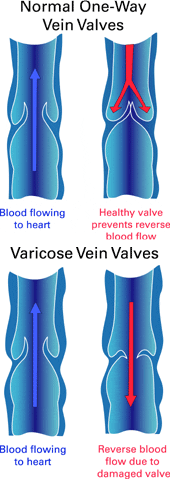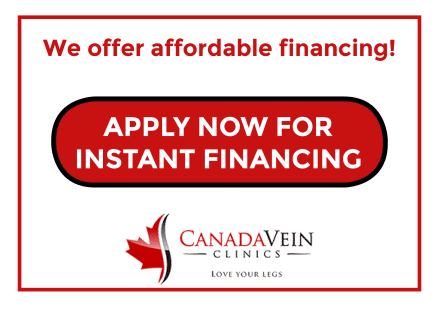
Venous Blood Flow
Arteries carry blood from the heart out toward the rest of the body, carrying oxygen to the tissues. Veins carry blood back to the heart, from the lower half of the body, against gravity to begin the cycle all over again. In healthy veins, there are one-way valves that act as a barrier ensuring that blood continually moves upward. For a variety of reasons, such as weight gain, pregnancy, hormonal changes, and our genes, the veins malfunction and this natural flow of blood is interrupted.
How do varicose veins form?
Calf muscles in the legs act as powerful pumps to push the blood back toward the heart, but the stress on these veins as they succumb to a great deal of pressure causes them to weaken. The walls of the veins in the legs distend (stretch), or the valves improperly open and close fully, so blood tends to pool, causing reflux.
The excess blood in the lower extremities is pushed out through the surface veins causing them to bulge outward as they collect the excess. Varicose veins are the large ropey veins that are noticeable on the surface of the skin in the legs. Over time, these veins can become painful and debilitating. Varicose veins are one of the most common vein insufficiency conditions known today.
Symptoms of varicose veins:

- Dull aching, heaviness, or cramping of the legs
- Itching and tingling
- Burning sensation in the legs
- Pain that gets worse when standing
- Pain that gets better when legs are raised
- Swelling of the legs
- Redness of the legs and ankles
- Skin color changes around the ankles
- Skin discoloration (bluing and browning of the skin)
- Thickening and hardening of the skin on the legs and ankles
- Ulcers on the legs and ankles
- Restless legs
Complications of Varicose Veins
Varicose veins are a sign of a dysfunctional circulatory system or chronic venous disease, and can lead to severe pain and discomfort. Varicose veins are most commonly found in the legs, but can appear in other areas of the body as well. Varicose veins can also progress to more complicated problems like skin pigmentation, eczema, restless leg syndrome (RLS), ulcers, cramps caused by simple movements, and the worst of all – chronic vein insufficiency. Varicose veins should be treated as soon as any of the above symptoms are experienced, as they can prohibit normal activities.
Solutions for Varicose Vein Removal
Canada Vein Clinics prides itself on being the most trusted institute for varicose vein consultation and removal. Our team of doctors and caregivers are known for their compassion and understanding, ensuring that every patient gets the personalized and effective treatment they deserve. With the best technology in laser vein treatment and a group of professionals with extensive experience in treating venous diseases, we can assure you that at Canada Vein Clinics, you will be in the most capable hands.
Our vein procedures include:
- Endovenous Laser Therapy
- ClariVein Treatment
- VenaSeal
- Mini-Phlebectomy
- Sclerotherapy
Still have questions about varicose veins and varicose vein treatment? Please consult our list of frequently asked questions or contact our office to schedule your assessment and consultation. With Canada Vein Clinics, your legs will be healthy, beautiful, and painless.

